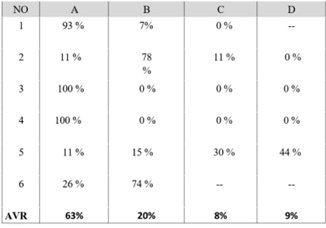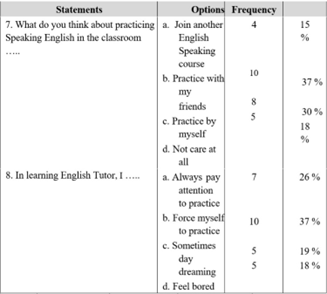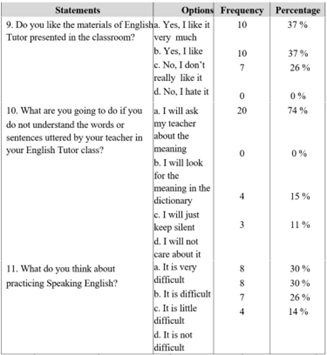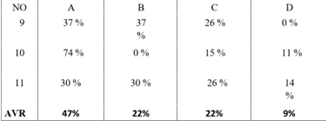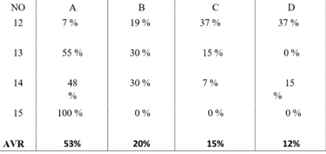International Learning Program (ILP): The Analysis of Students Motivation in Speaking English
- Ema Eliyana
- Djoko Sutrisno
- 305-312
- Apr 29, 2024
- Education
International Learning Program (ILP): The Analysis of Students Motivation in Speaking English
Ema Eliyana, Djoko Sutrisno
Universitas Ahmad Dahlan
DOI: https://dx.doi.org/10.47772/IJRISS.2024.804025
Received: 11 March 2024; Revised: 21 March 2024; Accepted: 26 March 2024; Published: 29 April 2024
ABSTRACT
The lack of excitement for training students’ speaking abilities is at the root of the problem in this study. Researchers are curious about: 1) This English Tutor exercise provides an incentive for students to practice speaking English. 2) Students’ conduct or effort in practising speaking English through English Tutor activities, attitudes, interests, values, or desires The design of this study is descriptive-quantitative. Creswell (2012: 13) describes quantitative research as defining a research challenge based on trends in the field or the need to explain why something occurs. According to the study’s findings, 1) the learner’s effort in practising speaking English among ILP students is 63% or higher. 2) the students’ interest in practising speaking English is 37%. 3) 47% of learners have a positive attitude regarding English-speaking practice. 4) the student has a 50% motivation to practice speaking English. The following are the findings: 1) Having a variety of learning activities and subjects available is beneficial for increasing motivation and offering opportunities for concept exploration. 2) To avoid monotony, vary the tactics employed in the learning process. 3) Rewarding and encouraging.
Keywords: Students Motivation, Speaking Skill, Speaking English, International Learning Program (ILP).
INTRODUCTION
English, as a second or foreign language, plays a critical role in education. Speaking is one of the talents that can be difficult to teach in English. (Widdowson, 1998) claims that speaking is the earliest and most universal means for humans to convey their thoughts and feelings. (Language and Mind with Noam Chomsky, 2014) defines spoken language as linguistic competence, ability, and performance. In other words, competency comes first, followed by performance. The foundation of the problem in this study is a lack of enthusiasm in teaching pupils’ speaking skills. According to (DOUGLAS & Frazier, 2001), one of the more difficult difficulties in learning and teaching a second language is defining and executing the concept of motivation in the classroom. Motivation is a concept that has no physical substance; we cannot see motivation; we can only observe behaviour. As a result, motivation is measured indirectly, much like any other psychological construct such as attitudes, interests, values, or desires. (Ihsan, 2016). Motivation is defined as the extent to which a communicator is drawn to or motivated to communicate well in specific settings (Vázquez-Martínez et al., 2021). According to (Crookes & Schmidt, 1991), “motivation has been identified as learner orientation with respect to the goal of learning a second language.”. (Leonard & Shea, 2017) it is taught that students who like the people who speak it, admire the culture, and have the desire to get to know or even integrate into the society in which that language is spoken are the most successful when learning the target language. This suggests that students who are most effective at learning the target language will at least replicate not only the culture but also the wants of the society in which the language is spoken (Leaver et al., 2005).
The International Learning Program (ILP) is a study abroad activity that aims to broaden students’ knowledge and experience across countries and cultures (Isabelli et al., 2018), (Le et al., 2017), (Hasegawa, 2019). Every week, 27 International Learning Program (ILP) participants participate in the English Tutor activity; these students are from one of East Java’s private schools. The rationale for selecting this research object is that we want to know the motivation of students who wish to participate in worldwide standard activities against students who merely study in class; the results will, of course, be quite different if studied. Furthermore, the focus of this study is on ILP students while they are studying with the English Tutor. English tutoring is specialized tutoring provided to ILP students to help them enhance their English skills, particularly their speaking abilities. Students attend this session twice a week for two months and must practice speaking English in monologue and dialogue based on the specified topic at each meeting. Researchers wish to know the following from these thoughts:
1) The incentive for pupils to practice speaking English through this English Tutor activity.
2) Students’ conduct or effort, attitudes, interests, values, or desires in speaking English through English.
METHODS
In this study, the population serves as the sample (Creswell, 2011), (Hatch, 2002) This study was followed by 27 EFL students of private junior high schools in East Java, Indonesia who were enrolled in the International Learning Program. Participants consisted of grade 7 (n = 6) and grade 8 (n = 21) with the genders of male (n = 17) and female (n = 10) students, their ages were between 14 and 15 years.
The questionnaire instrument was obtained from the research conducted (1584-Article Text-9995-1-10-20210911, n.d.), there are 4 indicators related to the students motivation in speaking English :
- The Student’s Effort in Practicing Speaking English
- The Student’s Interest in Practicing Speaking English
- The Student’s Attitude towards Practicing Speaking English
- The Student’s Desire in Practicing Speaking English
The data collection procedure was carried out in several stages. First, the researcher contacted and informed the ILP participants about the purpose of the study. After that, the researcher made a face-to-face appointment with each participant to carry out questionnaire activities. Then, the results were analyzed by the author.
This study has a descriptive-quantitative design. According to (Creswell, 2011), and (Creswell, 2008)(Creswell & Guetterman, 2018) quantitative analysis highlights a research topic based on field trends or the requirement to explain why something occurs. The questionnaire data is then evaluated to produce the following result using the following formula:
F / N multiplied by 100% equals the percentage
Explanation:
F: The number of students who completed the questionnaire regularly.
N denotes the total number of pupils.
It is then classified as follows:
100% refers to all of them.
80%-99% = the majority of them
60%-79% = a large number of them
40%-59% = a portion of them
21%-39% = a small number of them
1%-20% = a very small number of them
RESULTS AND DISCUSSION
The researcher is interested: 1) students’ motivation for speaking English through English Tutor activities. 2) Student conduct or effort, attitudes, interests, values, or desires in speaking English as part of English Tutor activities This research will undoubtedly be compared to earlier research undertaken by (Ihsan, 2016).
The first focus is on the results of students’ behaviour or efforts in practising speaking English: according to the questionnaire results, 63% of International Learning Program students attempted to practice speaking English; 20% of some ILP students attempted to train in spoken English; and 8% and 9%, or very few ILP students, attempted to practice speaking English. This suggests that ILP students’ interest in practising speaking English is quite high; this differs from prior research conducted by (Ihsan, 2016), in which attempts to practice speaking English were assessed to be still within the average limit. This discrepancy is related to students’ differing learning incentives in and out of class, especially when they are challenged in international activities. This initiative demonstrates students’ willingness to carry out ILP activities overseas by increasing their use of English and continuing to learn. (See Table 1) is an attachment.
The second focus stems from students’ desire to practice speaking English: according to the questionnaire results, 20% of ILP students want to practice speaking English; 37% of students want to practice speaking English; 25% or very few students want to practice speaking English; and only 18% of ILP students want to practice speaking English. The findings above reveal that the average student’s interest in practising English is still low, if not non-existent. The questionnaire findings show that there are numerous causes since there is a minor feeling of not caring, boredom, and sometimes daydreaming. This is in contrast to Ihsan’s earlier research (2016), which found that students found practising speaking English in class to be fascinating and enjoyable. (See Table 2 in the file).
The third focus stems from students’ attitudes toward practising speaking English: according to the questionnaire results, 47% or a few ILP students have an attitude toward practising speaking English. 22% of ILP students have a practising attitude toward speaking English; 22% of ILP students have an attitude toward speaking English practice; and 9%, or very few ILP students, have an attitude toward speaking English practice. That is, many ILP students have a negative attitude toward speaking English. This attitude demonstrates that kids like Students’ commitment to learning is demonstrated by their attitude toward the English tutor material offered in class, even though the findings of the questionnaire indicate that students occasionally find it difficult to practice speaking English. Of course, there are numerous variations between this and (Ihsan, 2016) research, such as the use of dictionaries, students’ material preferences, and so on (See attachment: Table 3).
The fourth focus is the result of students’ desire to practice speaking English: according to the questionnaire results, 53% of ILP students want to practice speaking English; 20% of ILP students want to practice speaking English; 15% of ILP students want to practice speaking English; and 12% of ILP students want to practice speaking English. This suggests that over half of the pupils want to practice speaking English. According to this desire, students practice speaking English because they want to be able to speak English fluently; they practice speaking English because they want to be able to talk and converse with native speakers; and they consider their future, which includes looking for a job that speaks English. Previous research (Ihsan, 2016) found nearly identical explanations; the percentages were merely different (See attachment: Table 4).
CONCLUSIONS
Based on the information gathered from the questionnaire, the following conclusions were reached: According to the study’s findings, 1) the learner’s effort in practicing speaking English is 63% or higher of International Learning Program students who have attempted to practice speaking English. 2) Only 37% of pupils want to practice speaking English. Some ILP students want to improve their English skills. 3) The learner’s attitude toward English speaking practice is 47%, indicating that some ILP students have an attitude toward practicing speaking English. 4) The learner’s willingness to practice speaking English is 50%, or some ILP students want to practice speaking English. The conclusions are as follows: 1) A range of learning activities and themes is critical for improving motivation and providing excellent possibilities for students to explore their ideas. 2) Vary the strategies used in the teaching and learning process to avoid monotony. 3) Awarding prizes motivates and rewards pupils who can effectively express themselves in English. 4) Creating a welcoming environment in the classroom Previous research conducted by (Ihsan, 2016) discovered several disparities in the motives for practising speaking English, particularly in student effort, attitude, and willingness to practice speaking English. We both examined EFL students for commonalities. The limitations in obtaining data sources are a personal evaluation from the author and it is hoped that there will be development of other research methods in the future so that more valid data can be obtained with a wider description of the research results so that they can become new findings with various communities and samples that are useful for future research studies. coming.
REFERENCES
- 1584-Article Text-9995-1-10-20210911. (n.d.).
- Creswell, J. (2008). Educational Research: Planning, Conducting, and Evaluating Quantitive and Qualitative Research.
- Creswell, J. (2011). Educational Research Planning: Planning, Conducting, and Evaluating Quantitative and Qualitative Research.
- Creswell, J., & Guetterman, T. (2018). Educational Research: Planning, Conducting, and Evaluating Quantitative and Qualitative Research, 6th Edition.
- Crookes, G., & Schmidt, R. W. (1991). Motivation: Reopening the Research Agenda. Language Learning, 41(4), 469–512. https://doi.org/https://doi.org/10.1111/j.1467-1770.1991.tb00690.x
- DOUGLAS, D. A. N., & Frazier, S. (2001). Teaching by Principles: An Interactive Approach to Language Pedagogy (2nd ed.).: H. Douglas Brown. TESOL Quarterly, 35. https://doi.org/10.2307/3587655
- Hasegawa, A. (2019). The Social Lives of Study Abroad: Understanding Second Language Learners’ Experiences through Social Network Analysis and Conversation Analysis. https://doi.org/10.4324/9780429505829
- Hatch, J. A. T. A.-T. T.-. (2002). Doing qualitative research in education settings (NV-). State University of New York Press Albany. https://doi.org/LK – https://worldcat.org/title/53443760
- Ihsan, M. (2016). Students’ Motivation in Speaking English. Journal of English Educators Society, 1. https://doi.org/10.21070/jees.v1i1.147
- Isabelli, C., Bown, J., Plews, J., & Dewey, D. (2018). Language learning and study abroad. Language Teaching, 51, 439–484. https://doi.org/10.1017/S026144481800023X
- Language and mind with Noam Chomsky. (2014). Kanopy Streaming [San Francisco, California, USA]. https://doi.org/LK – https://worldcat.org/title/897768204
- Le, H., Janssen, J., & Wubbels, T. (2017). Collaborative learning practices: teacher and student perceived obstacles to effective student collaboration. Cambridge Journal of Education, 48, 1–20. https://doi.org/10.1080/0305764X.2016.1259389
- Leaver, B., Ehrman, M., & Shekhtman, B. (2005). Achieving Success in Second Language Acquisition. Achieving Success in Second Language Acquisition, 1–265. https://doi.org/10.1017/CBO9780511610431
- Leonard, K., & Shea, C. (2017). L2 Speaking Development During Study Abroad: Fluency, Accuracy, Complexity, and Underlying Cognitive Factors. Modern Language Journal, 101. https://doi.org/10.1111/modl.12382
- Vázquez-Martínez, U., Morales Mediano, J., & Leal-Rodriguez, A. (2021). The Impact of the COVID-19 Crisis on Consumer Purchasing Motivation and Behavior. European Research on Management and Business Economics, 27, 100166. https://doi.org/10.1016/j.iedeen.2021.100166
- Widdowson, H. G. (1998). Skills, abilities, and contexts of reality. Annual review of applied linguistics TA – TT -. https://doi.org/LK – https://worldcat.org/title/808006933
APPENDICES
Table 1 The questionnaire 1) The Student’s Effort in Practicing Speaking English
Using a graphic:
Table 2 The questionnaire 2) The Student’s Interest in Practicing Speaking English
Using a graphic:
Table 3 The questionnaire 3) The Student’s Attitude towards Practicing Speaking English
Using a graphic:
Table 4 The questionnaire 4) The Student’s Desire in Practicing Speaking English
Using a graphic:


